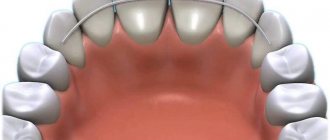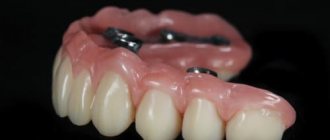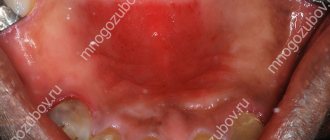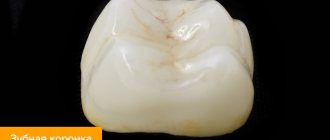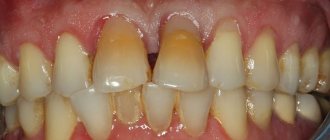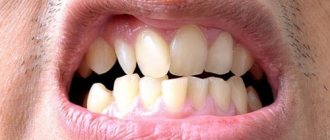Gap between teeth occurs in almost twenty percent of people, and is most often observed between the two front teeth. In preschool children, gaps occur quite often, but over time, such a defect goes away on its own. In adults, the problem is not a death sentence, but it can signal the presence of certain pathologies or provoke orthodontic problems. If the patient is concerned about this large distance, the issue needs to be resolved, especially since modern dentistry offers a lot of techniques.
Gaps between teeth are considered natural to be 1 mm, and pathological - from 1 to 7 mm. It is normal when the side surfaces touch each other. If this is not the case, a diastema (another scientific name for distance) is diagnosed.
When the teeth touch each other, the chewing load is distributed evenly. Also, bacteria accumulate less in the interdental spaces, which means the risk of caries is reduced. Accordingly, if there is a distance, the dental units cannot cope with the loads and the risk of dynamic development of extensive caries is high.
What is the name of the gap between the teeth?
The scientific name for the gap between the upper front incisors is diastema. Dentists divide diastemas into true and false. The latter are temporary large gaps in children and adolescents, which appear due to too early loss of baby teeth, an incompletely formed bite and some other orthodontic phenomena, but disappear naturally over time. True diastemas in children and adults are gaps between the front teeth, which are corrected only after certain treatment.
As for the enlarged spaces between the lateral teeth, they are called trema; they arise due to the beginnings of “extra” teeth and other disturbances during the formation of the bite. Tremas can also appear after the loss or removal of one or more teeth, when the remaining teeth “diverge”, taking up the vacant space.
Complications
The first signs of crowding of teeth can be noticed in early childhood, even on baby teeth: if there are no spaces between them, then most likely there will be too little space for permanent teeth. Without timely treatment, as you get older, the situation will worsen and complications will appear.
Caries. Teeth that are closely spaced and piled on top of each other are difficult to clean, so plaque accumulates in hard-to-reach places, tartar often forms and caries occurs, often in a hidden form. Untimely detected dental damage makes their treatment impossible and leads to removal, and the lack of several dental units begins to negatively affect the chewing of food and the functioning of the gastrointestinal tract.
Inflammation of soft tissues. The spread of tartar entails inflammatory processes in the periodontium: periodontitis, abscesses, periostitis (inflammation of the periosteum), etc. Lack of timely treatment can lead to damage to the periodontium (deep tissues around the tooth root), bleeding, gum recession, mobility and loss of teeth, development periostitis and lymphadenitis.
Increased crowding. Teeth crowding can increase as a person gets older, as the ligamentous apparatus of the tooth becomes less stable.
Traumatic bite. Incorrect closure of displaced teeth disrupts the balance of chewing load. The result is increased sensitivity and abrasion of tooth enamel.
Why did gaps appear between teeth?
In childhood, a gap between the front teeth most often appears when the frenulum of the upper lip is attached too low - almost between the teeth. This applies to the front teeth. Another common reason why gaps appear between a child’s teeth is the buds of “extra” teeth that form in the jaw bone and prevent the teeth from closing together. However, very often a large gap between the teeth, both front and side, in children and even adolescents is a temporary phenomenon and disappears on its own when the bite is finally formed.
At the same time, in many cases, the gap remains in adulthood, if it is not very large and the rest of the smile is proportional, it is even considered a kind of highlight.
Background - total dental prosthetics
Doctors at the Family Dentistry performed very complex work on dental prosthetics with ceramic crowns, some of which were installed on dental implants (read more about this work here). Total prosthetics was performed - all 28 of the patient’s teeth were restored with ceramics. At the same time, the bite, facial proportions, length and inclination of the teeth were changed. Which, accordingly, required adaptation of the patient’s neuromuscular system to new conditions. The temporomandibular joints, the muscles of the lips and tongue, and the muscles that move the lower jaw and neck had to accept the new teeth and adjust to working with them. Usually such adaptation occurs without problems within a short period of time. But in some cases, muscle tone and a certain activity inherent in the muscles before prosthetics remain after prosthetics and spoil the achieved result.
Compare the situation before and after prosthetics using the most modern Astra Tech dental implants and the most modern E.max restorative ceramics:
The excellent results of prosthetics are obvious. But almost immediately after dental prosthetics, the attending physician Tsukor S.V. I noticed a trend - the lower front teeth have moved slightly apart. At the same time, the position of the remaining teeth remained stable.
What does a gap between teeth mean?
As we have already said, large gaps between the teeth may mean that there are rudiments of “extra” teeth in the jaw bone. This phenomenon can be easily determined using an x-ray; it can also reveal another reason for the formation of a gap between the front incisors - an overdeveloped bone septum. But most often, diastemas arise from a low-attached frenulum of the upper lip. In many cases, eliminating gaps between teeth corrects not only the aesthetics of the smile, but also functional problems - speech defects caused by diastema, malocclusion and others. In addition, quite often people who are critical of their appearance consider their gaps between their teeth to be an obvious defect, which leads to decreased self-esteem and psychological problems. In any case, diastemas and trema are treatable. At your request, the doctor will always be able to remove the gap between the front teeth, even if your case is not critical and does not threaten health problems.
Types of distances between teeth
- Trema between teeth - spaces between dental units, with the exception of incisors. In this case, the pathology may not bother the patient for a long time, but it will be determined by the dentist during the examination;
- Diastema is a gap between the upper and lower incisors, which can lead to problems with pronunciation and speech in general, as well as with the aesthetics of the smile.
The distance between the front incisors, if it is not pathological, may not be treated. The most famous owners of diastemas are Vanessa Paradis, Madonna, Katy Perry and many others.
How to remove a gap between teeth?
If you are unhappy with the gap between your front teeth or want to get rid of three, consult a dentist. At the first appointment, he will determine the reason why you have a gap between your front teeth or gaps between your side teeth, and will draw up a treatment plan. An x-ray or orthopantomogram may be required. Next, the doctor decides how to correct the gaps between the teeth in a particular case.
If the cause of the diastema is the frenulum of the upper lip, then correcting the gap between the teeth will require plastic surgery of the frenulum and minor orthodontic treatment. Trimming the frenulum in modern dentistry is performed bloodlessly and painlessly using a laser, and braces will help “move” the teeth. If you are concerned about your appearance during treatment, the orthodontist will advise you to use lingual braces - they are attached to the back surface of the teeth and are completely invisible. Sometimes you can do without braces at all; in such cases, transparent aligners are used.
If the gap is formed due to an overdeveloped bone septum, the intervention of an oral and maxillofacial surgeon may be required. But, as a rule, the problem of the gap between the front incisors can be solved very quickly by replacing the front teeth with ultra-modern restorations, for example, composite veneers.
What determines the stability of treatment?
The preservation of the result in orthodontics is usually called retention. Retentio is a Latin term meaning "preservation", "retention". So, maintaining a beautiful smile does not depend on the money paid by the patient. Even after correction with the coolest expensive ceramic braces or transparent Invisalign aligners, the teeth can move apart very quickly. In some cases, this is due to the fault of the doctor, but much more often the patient himself becomes the source of the problem.
- The teeth will definitely become crooked again if the orthodontist has not identified and eliminated the real cause of the anomaly.
- The doctor is also responsible for the correctness of the treatment program. This means that he must correctly choose the orthodontic design and directions of tooth movement, as well as carefully approach the need to remove those that interfere with effective correction.
- When drawing up a program, a professional will initially focus on a high-quality result, and not on accelerated treatment. With a patient who wants to wear only the “magic” Smartclip self-ligating braces in order to have as few visits to the clinic as possible and correct the bite faster, it is difficult to find a compromise. But without this, it will be impossible to realize his dream of an even, white-toothed smile.
- Finally, to consolidate the result after removing braces, the specialist must offer the patient the optimal retention device. In this case, one should take into account the psychological characteristics of the individual demonstrated during long-term treatment.
This limits the orthodontist's responsibility. If all the rules were followed, and the teeth become crooked again, the patient can only blame himself.
Photos of stars with a gap between their teeth
Many stars not only do not seek to correct the gap between their teeth, but also insist that this is their distinctive feature, such as Lily Aldridge, who forbids photographers to “Photoshop” her smile. Dentists have different opinions on this matter: some consider the gap between the teeth a defect and insist on correcting it, others believe that if the increased gap between the teeth does not interfere with its owner’s life, then it is not worth touching it and once again injuring the oral cavity.
Cher Lloyd
A popular participant in the English release of the cult show X Factor chose to get rid of the gap between her teeth using aesthetic teeth extensions and, I must admit, she made the right choice.
Zac Efron
The reason why Zac Efron decided to fix the gap between his front teeth is clear. Shcherbinka gave him a too immature look, while the actor dreamed of serious roles in films. And in order for dreams to come true, you have to sacrifice something.
Madonna
Madonna has never had any serious problems with her teeth, except for a small gap. But over the years, she still needed the help of an esthetician dentist. Madonna had the shape and color of her teeth corrected, but the gap between her teeth remained, which looks very natural and does not spoil her at all.
Participation of a speech therapist in dental treatment
Considering the situation from all sides, the doctors paid attention to the position of the woman’s tongue. The fact is that normally, the pressure of the tongue from inside the mouth should be directed to a certain point on the palate. With the loss of teeth, their wear, malocclusion, and for a number of other reasons, the tongue begins to put pressure not on the palate, but on the teeth from the inside. The tongue is a powerful muscle that can develop pressure up to 500 g. This pressure is enough to force the teeth apart. Normally, the pressure of the tongue is partially or completely balanced by the muscles of the lips. Myodynamic balance occurs at rest and during function (eating, swallowing, speaking, etc.). With muscular balance, the teeth stand exactly for years and no deformations occur. If the deformity progresses, it means that the pressure of one muscle dominates, causing the teeth to shift. In this case it was language.
The Family Dental Clinic employs a neuromuscular therapist with a primary specialty of speech therapist, T. B. Tsukor. She knows everything about the work of the tongue, lips and facial muscles. It was she who was approached by an orthopedic doctor in order to solve the issue of tongue dysfunction and help the patient.
After analyzing the situation, the speech therapist came to the conclusion that the tongue is really to blame for the fact that the teeth are moving apart and the gaps between the teeth are increasing. The tongue pressed from the inside incorrectly - not on the front of the palate, but on the lower teeth. This situation with the incorrect position of the tongue had happened before and arose as a result of the patient’s difficult situation associated with the absence of many teeth and bite deformation. The bite was corrected, but the tongue muscles continued to work in a dysfunctional mode. The doctors were faced with the task of dealing with the dysfunction in order to stabilize the situation. An examination by our special and very rare speech therapist-neuromuscular therapist revealed weakness of the patient’s lower lip. This became an additional factor in aggravating the deformity, since the lip did not provide the necessary resistance.
Speech therapist's appointment:
The speech therapist, having conducted an examination and identified the causes of the incident, passed on the information to the treating prosthetist. The speech therapist offered the patient a set of exercises to normalize the position of the tongue and strengthen the lips. The complex included exercises for the lips, for the tongue, for developing a directed air stream, and for producing sounds. The patient performed this complex at home with periodic control conversations with a speech therapist via Skype. Skype checks made it possible for the patient not to come to the clinic and saved her time and effort. Classes with a speech therapist via Skype are a valuable opportunity that Dial-Dent provides to its clients. The patient performed the exercises exactly as prescribed. This is very important to achieve results. The teeth stopped moving apart, and the situation stabilized. But the initial result was already lost, and doctors had to decide how to return the lower teeth to their previous positions.
Methods for correcting front teeth of different lengths
Discrepancy in the coronal height of the central incisors can be corrected in several ways.
- Filling. Photopolymer restoration is the most affordable method of restoring the optimal length of teeth. Using composite material, you can build up the missing part of the crown.
- Wearing braces. Orthodontic treatment allows you to eliminate various defects in the dentition, including shortening and lengthening of one of the incisors.
- Installation of veneers. Ceramic or porcelain onlays replace the outer layer of teeth and provide the desired length. You can choose plates of a natural shade or snow-white.
When choosing an appropriate correction method, it is necessary to take into account the degree of deviation of the tooth height from the norm and the characteristics of the bite.
Retention period
The time when the patient is forced to wear a special retention guard or plate is called retention. This must be done, otherwise the teeth may quickly return to their previous location. Depending on certain factors, the orthodontist may prescribe the wearing of mouth guards, metal plates, or the installation of permanent wires.
The mouthguards should be worn all day and night, only being removed when eating and cleaning the mouth. Over time, it is possible to reduce the time of their use, for example, every other day. Mouthguards have many advantages; they have a shade similar to the color of your own tooth enamel, so they are not visible to others. They can be worn on one jaw or both at once. In some cases, metal wires are inserted into the aligners to help increase their rigidity.
Another option for retainers is a permanent wire. It has sufficient rigidity, so the teeth will remain in the desired position. It is attached to the inside of the dentition, which makes the treatment process invisible to others. Installation of the wire should be carried out only by an experienced specialist; this will allow you to achieve the desired result in the shortest possible time.
Causes of dental defects
Lengthening or shortening of one of the incisors is usually a congenital anomaly. This feature of dentition development is associated with genetic factors. Experts also include the following as possible causes of the problem:
- periodontitis,
- malocclusion,
- presence of supernumerary teeth,
- abnormal shape of the alveolar process,
- disruption of the process of resorption of the roots of baby teeth.
Changes in the length of the central incisor can also be a consequence of jaw trauma. If a tooth is mechanically damaged, its lower part may chip. Because of this, the appearance of the smile deteriorates, discomfort occurs when chewing, and the risk of developing various diseases increases.
Duration of retention period
The duration of this period largely depends on the complexity of the pathology that was initially diagnosed in the patient. Long-term wearing of fixation products is necessary when treatment of a deep, distal or open bite took place. In this case, you will need to use the retainer for almost the same period as the person wore braces (up to 2.5 years).
It is important to understand that the duration of the entire therapy is also influenced by the age of the individual patient. In children, correction and rehabilitation occurs much faster than in adults. This is due to the fact that the tissues of the jaw are not yet strong enough and are better susceptible to external influences. Some patients cannot achieve stable results even with constant wearing of a mouthguard, in which case the doctor will advise using a retainer for life.
To be sure of an ideal result, the patient should regularly visit the clinic for examination and make changes to the treatment regimen if necessary. Only a competent approach, careful attitude and following the prescribed recommendations will allow you to maintain the beautiful smile obtained during orthodontic treatment.
previous post
What can you eat after dental implantation?
next entry
